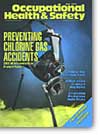
May 2005
Cover Story
By Alan Austin
WHILE you might not realize it, the chemical chlorine (Cl2) and its compounds are part of almost everyone's daily life. The water you drink, the food you eat, the medicine you take, the clothing you clean, the pool you swim in, the car you drive, and thousands of other products are sanitized or manufactured with chlorine.
Features
By Casey Hayes
"WHEN you have bacon and eggs for breakfast, the chicken is involved, but the pig is committed!" I don't remember where I first heard that saying, but it humorously portrays the difference between participating in an event and being an intimate part of the action. In that regard, it also applies to spill and splash accidents at industrial sites.
By Ronnie Rittenberry
If you've visited an amusement park or outdoor fair in recent years, you've likely encountered with relief the misting stations that are something like the distant cousins of these fogging systems. Heat is by far the number one source of illness and injury at theme parks, largely because visitors often aren't acclimated to the extreme temperatures or aware until it's too late how vulnerable their bodies are to the conditions.
By Alfred C. Draper III
So just how hazardous is mold, and what are the real risks to a facility and its occupants? Here's what we know: Mold is naturally occurring fungi that can thrive wherever moisture is present, especially in combination with poor ventilation and humidity above 60 percent.
By Bob Henderson
OXYGEN deficiency is one of the most common of all categories of atmospheric hazards. It stands to reason that the sensors used to measure oxygen concentration are one of the most widely used types of sensors included in portable atmospheric monitors, especially those used in confined space monitoring procedures.
By George R. Blank
RESPIRATOR protection is a broad subject that can be complicated and misunderstood by even the most experienced people. The importance of proper respiratory protection cannot be understated. This article will cover only a small segment of this vast subject.
By Richard Harris
SAFETY interlocks, safety light curtains, and other safety equipment are the visible part of a machinery safeguarding system. As such, they receive the most attention. However, true safety goes well below the surface of any machinery guarding control system.
By William R. Coffey Jr., CSP, CPEA
"THOSE who can not remember the past are condemned to repeat it."1 There is no better sentiment to begin a discussion on accident investigation than this. It is a bad thing when a person is injured.
By Linda F. Johnson, MS, CSP
UNLIKE the days of long ago, in our modern workplaces the armor of Personal Protective Apparel (PPA) awaits almost any situation from the extreme to the daily grind.
By Dave Kuiawa
THE firefighter's work of suppressing a blazing structure is the beginning of a string of activities that includes investigation of possible cause and potential criminal prosecution if arson is suspected. Once the flames are finally extinguished and the structure is secured, the work of determining the cause of a fire begins.
Departments
By Blaise Grock
SAFETY professionals know the importance of providing orientation training to recently hired workers, but what about temporary labor? Given the fast pace of industry these days, providing training for large numbers of "temps" can be a daunting task but is well worth the effort.
By Emily Bryant
I often consider myself something of a Neo-Luddite (one who opposes technological advances), railing against overzealous cellphone users and people who spend too much time on the Internet. Having said that, my only phone is a cellphone, and I pay top dollar for broadband Internet access at home.
By Jerry Laws
THE International Association of Fire Fighters has been conducting Weapons of Mass Destruction and hazardous materials training on a grand scale this year, bringing to thousands of firefighters the latest information on terrorism preparedness.